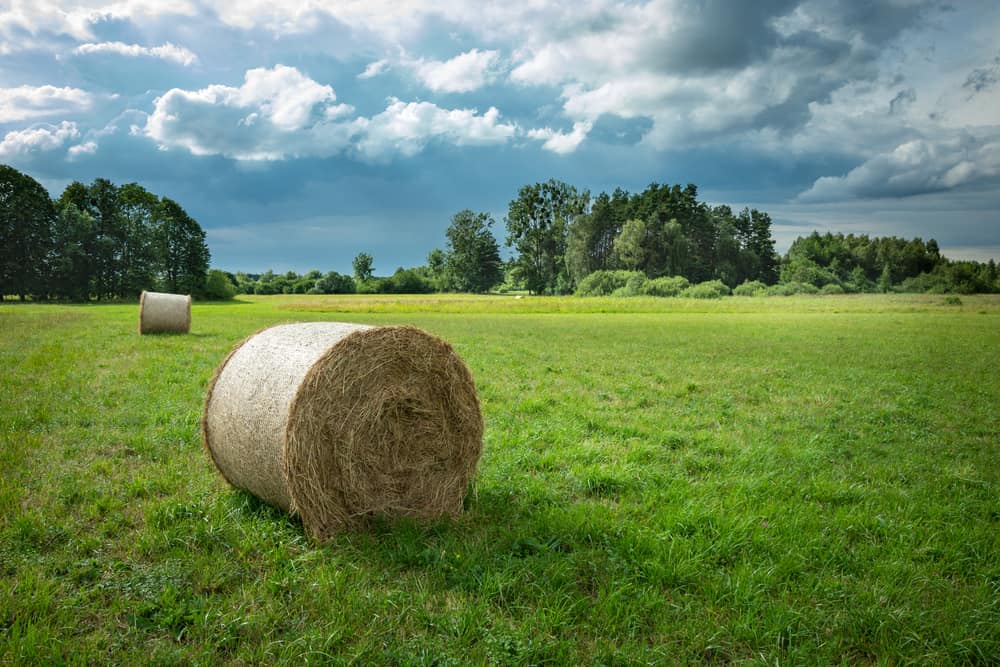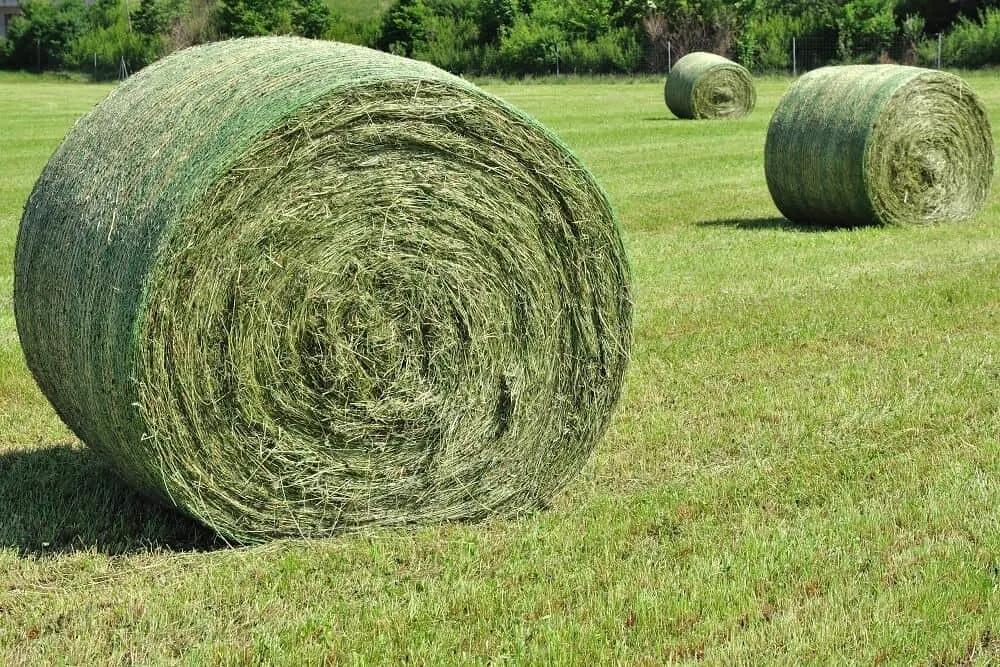Several individuals have made searches on Google to know how much does a round bale of hay weigh. The weight of a single round hay bale can range anywhere from 400 to 1700 pounds (181-771 kg). The weight of a small hay bale measuring 4 feet by 4 feet (121 cm by 121 cm) is approximately 400 to 600 pounds (181-272 kg), while the weight of a medium hay bale measuring 5 feet by 4.5 feet (152 cm by 137 cm) can range anywhere from 720 to 950 pounds (326.6-431 kg), and the weight of a large round bale measuring 5 feet by 6 feet (152 cm by 182 cm) can range anywhere from 1270 to 1700 pounds (576-771 kg). A typical square bale measuring 4 feet by 5 feet (121 cm by 152 cm) and weighing between 600 and 800 pounds (272-363 kg). One kind of hay bale is round, and the other is square. Both types are available. The weight of two hay bales can differ, even though their dimensions and sizes are identical.
Hay is a term that refers to legumes, dried and cut grass, and other plants suitable for consumption by grazing animals such as horses, sheep, and cows. The term “hay” was coined in the 18th century. Tortoises, rabbits, and other small animals like that will also consume them. Most farm animals prefer hay because it is green and easy for them to chew on. If the bales are very large, they are bundled together and then wrapped in plastic so that they can maintain their green and healthy appearance.
You’ll Also Like: What to Look for When Hiring Commercial Painting Services in Kyle, TX
What Is The Typical Weight Of A Round Bale Of Hay?
A two-string square hay bale can range from 40 to 75 pounds (18-34 kg). Some three-string square bales weigh approximately 140 lb (64 kg), while others weigh approximately 100 lb (45 kg) (63.5 kg). There is a significant range in weight from 563 to 1,584 pounds for round hay bales, with an average weight of about 1,250 pounds (567 kilograms) (255-718.5 kg). It is difficult to measure because the weight of the bale is affected by the amount of moisture it contains, and it is recommended that a weighing scale be used to accurately measure the weight of hay bales. The bales are available in a variety of dimensions and weights.
The shape of the bale, whether it is round or square, the density of the bale, the size of the bale, and the amount of moisture it contains are all factors that contribute to the overall weight of the hay bale. Two-stringed square bales measuring approximately 36 inches by 19 inches by 16 inches (91 centimeters by 48 centimeters by 40 centimeters) and weighing approximately 40 to 75 pounds each (18-34 kg).
The weight of three-stringed square bales that measure 44 inches by 22 inches by 15 inches (111 centimeters by 55 centimeters by 38 centimeters) is between 100 and 140 pounds (45-63.5 kg). Approximately one thousand pounds of square bales measuring 6 feet by 4 feet by 3 feet (182 centimeters by 121 centimeters by 91 centimeters) weigh a half-ton each (453.6 kg). It is possible for a full ton of square bales that measure 8 feet by 4 feet by 4 feet (243 cm x 121 cm x 121 cm) to weigh as much as 2,000 pounds (907 kg).
Hay bales can be either round or square, but there are some key distinctions between the two.
The primary distinction between round bales and square bales is the ease with which farm animals can be fed from round bales, as opposed to square bales, which require significantly more effort and time. The tight compression that round bales have makes them less susceptible to damage, making them less likely to go bad.
On the other hand, the loose compression that square bales have makes it easy for them to go bad if they are not stored properly. However, square bales are easier to transport because they are less cumbersome and more sturdy and stable than round bales. Because round bales are prone to rolling around in trucks, transporting them can be challenging. Compared to square bales, round bales are more difficult to store because they require greater stability to maintain their shape.
How Many Pounds Does A Common Round Bale Of Hay Typically Weigh?
The weight of a regular round hay bale can range anywhere from 1200 to 1700 pounds (544-771 kg). Round hay bales of alfalfa weigh approximately 1,200 to 2,000 pounds (544 to 907 kg), while alfalfa bales with three strings weigh approximately 110 to 140 pounds (50 to 63.5 kg), and small alfalfa bales with two strings can weigh anywhere from 60 to 70 pounds (27-31.8 kg). On the other hand, the weight of a grass hay round hay bale ranges between 1270 and 1700 pounds (576-771 kg). A grass hay bale with three strings typically weighs between 75 and 90 pounds (34 to 41 kilograms), while a smaller bale with two strings typically weighs between 40 and 55 pounds (18-25 kg).
The amount of protein in grass hay and alfalfa hay are two different things. In comparison, the percentage of protein found in grass hay is only 10%, while alfalfa hay has a protein content that ranges from 15-21%, depending on when the alfalfa was diced.
How Many Bales Of Hay Do The Farm Animals Require Per Day?

A mature cow that gets all of its forage from hay alone will require an amount of hay equal to three percent of its body weight each day, which works out to approximately thirty pounds (13.6 kilograms) of hay per day.
Hay is the primary source of protein and many other nutrients for all farm animals. It is essential to provide them with protein in addition to all the nutrients in proportion to the amount of food they consume and their body weight. The following is a list of animals and the value of the daily percentage of hay requirement specific to each animal.
- Three percent of the cow’s total body weight
- 2 percent of the sheep’s total body weight
- 2 percent of the goat’s total body weight
- Two percent of the horse’s total body weight
- 1% of the beef steer’s total body weight is fat.
- Llama 3% of their body weight
The following equation, which takes into account the percentage of the animal’s body weight, can be used to determine the amount of hay (dry matter) that the animal needs to consume on a daily basis:
The required percentage of the farm animal’s body weight is multiplied by the animal’s weight in kilograms. How many days of ‘feeding’ equals how much hay needs to be baled
A horse or any other farm animal losing weight should be fed chopped hay with alfalfa or a mixture of high-quality grass hay and alfalfa. Another alternative is to feed the animal a mixture of grass hay and alfalfa. In 2020, the price of a ton of round bales of hay that are very large will range between $75 and $90. The price of a ton of hay in the form of alfalfa bales ranges between $140-165. In the same vein, the price of a ton of grass ranges between $125 and $150.
The typical daily consumption of hay by horses that get all of their forage from hay is between 7-9 kg and 15-20 lb. For optimal health and development, an adult horse should aim to consume between 2% and 2.5% of their body weight in food each day. Hay bales of premium quality can cost anywhere from $195 to 243 dollars per ton, bales of grade one can cost anywhere from $152 to 229 dollars per ton, bales of grade two can cost anywhere from $116 to 137 dollars per ton, and bales of grade three can cost anywhere from $105 to 123 dollars per ton.
How Does One Determine the Weight of a Round Bale of Hay?
Simply dividing the estimated dry matter weight by the percentage of dry matter in the bale will allow you to convert the weight of the hay as fed or as a wet bale. The load varies according to the size of the hay bale as well as the density of the bale. A piece of machinery or equipment called a baler is required to compress hay into bales.
You’ll Also Like: Here’s Why Mobile Home Owners Invest In Skirting And Underpinning
Conclusion
Hay bales have a certain percentage of moisture content, which determines the overall weight of the bale. As a result, it isn’t easy to produce bales that are all the same weight. It is best to use a weighing scale in order to obtain how much does a round bale of hay weigh.







